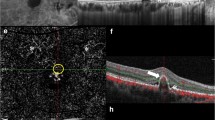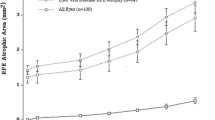Abstract
Purpose
To investigate the characteristic appearances of fundus autofluorescence (FAF) in patients with treatment-naive and active polypoidal choroidal vasculopathy (PCV).
Method
Cases with the diagnosis of treatment-naive and active PCV from November 2012 to May 2017 at Peking Union Medical College Hospital were retrospectively reviewed. All patients underwent comprehensive ophthalmologic examination. Autofluorescence (AF) findings were described at the retinal sites of the corresponding lesions identified and diagnosed using indocyanine green angiography and spectral-domain optical coherence tomography.
Results
One hundred seventy patients with 192 affected eyes were included. The logMAR BCVA of the patients were 0.53 ± 0.28. The six AF patterns of 243 polypoidal lesions were confluent hypo-AF with hyper-AF ring (49.8%), confluent hypo-AF (22.6%), hyper-AF with hypo-AF ring (3.7%), granular hypo-AF (7.0%), blocked hypo-AF due to hemorrhage (8.6%), and polyps without apparent AF changes (8.2%). For 146 branching vascular networks (BVNs), 97.3% were granular hypo-AF, and others were blocked hypo-AF due to hemorrhage.
Conclusion
In eyes with treatment-naive and active PCV, the polypoidal lesions and BVNs induce characteristic FAF changes. FAF images provide reliable adjunct reference for the diagnosis of PCV.







Similar content being viewed by others
References
Yannuzzi LA, Sorenson J, Spaide RF, Lipson B (1990) Idiopathic polypoidal choroidal vasculopathy (IPCV). Retina 10(1):1–8
Yannuzzi LA, Ciardella A, Spaide RF, Rabb M, Freund KB, Orlock DA (1997) The expanding clinical spectrum of idiopathic polypoidal choroidal vasculopathy. Arch Ophthalmol 115(4):478–485
Spaide RF, Yannuzzi LA, Slakter JS, Sorenson J, Orlach DA (1995) Indocyanine green videoangiography of idiopathic polypoidal choroidal vasculopathy. Retina 15(2):100–110
Klaver CC, Wolfs RC, Vingerling JR, Hofman A, de Jong PT (1998) Age-specific prevalence and causes of blindness and visual impairment in an older population: the Rotterdam Study. Arch Ophthalmol 116(5):653–658
Lorentzen TD, Subhi Y, Sørensen TL. (2017) Prevalence of polypoidal choroidal vasculopathy in white patients with exudative age-related macular degeneration: systematic review and meta-analysis. Retina. https://doi.org/10.1097/IAE.0000000000001872
Sho K, Takahashi K, Yamada H, Wada M, Nagai Y, Otsuji T, Nishikawa M, Mitsuma Y, Yamazaki Y, Matsumura M, Uyama M (2003) Polypoidal choroidal vasculopathy: incidence, demographic features, and clinical characteristics. Arch Ophthalmol 121(10):1392–1396
Wen F, Chen C, Wu D, Li H (2004) Polypoidal choroidal vasculopathy in elderly Chinese patients. Graefes Arch Clin Exp Ophthalmol 242(8):625–629
Liu Y, Wen F, Huang S, Luo G, Yan H, Sun Z, Wu D (2007) Subtype lesions of neovascular age-related macular degeneration in Chinese patients. Graefes Arch Clin Exp Ophthalmol 245(10):1441–1445
Maruko I, Iida T, Saito M, Nagayama D, Saito K (2007) Clinical characteristics of exudative age-related macular degeneration in Japanese patients. Am J Ophthalmol 144(1):15–22
Koh AH, Chen LJ, Chen SJ, Chen SJ, Chen Y, Giridhar A, Iida T, Kim H, Yuk Yau Lai T, Lee WK, Li X, Han Lim T, Ruamviboonsuk P, Sharma T, Tang S, Yuzawa M (2013) Polypoidal choroidal vasculopathy: evidence-based guidelines for clinical diagnosis and treatment. Retina 33(4):686–716
Wong RL, Lai TY (2013) Polypoidal choroidal vasculopathy: an update on therapeutic approaches. J Ophthalmic Vis Res 8(4):359–371
Oztas Z, Sigford DK, Tezel TH (2016) Characteristics of fundus autofluorescence in active polypoidal choroidal vasculopathy. Turk J Ophthalmol 46(4):165–168
Delori FC, Dorey CK, Staurenghi G, Arend O, Goger DG, Weiter JJ (1995) In vivo fluorescence of the ocular fundus exhibits retinal pigment epithelium lipofuscin characteristics. Invest Ophthalmol Vis Sci 36(3):718–729
von Ruckmann A, Fitzke FW, Bird AC (1997) Fundus autofluorescence in age-related macular disease imaged with a laser scanning ophthalmoscope. Invest Ophthalmol Vis Sci 38(2):478–486
von Ruckmann A, Fitzke FW, Bird AC (1995) Distribution of fundus autofluorescence with a scanning laser ophthalmoscope. Br J Ophthalmol 79(5):407–412
Schmitz-Valckenberg S, Holz FG, Bird AC, Spaide RF (2008) Fundus autofluorescence imaging: review and perspectives. Retina 28(3):385–409
Suetsugu T, Kato A, Yoshida T, Yasukawa T, Nishiwaki A, Hasegawa N, Usui H, Ogura Y (2016) Evaluation of peripheral fundus autofluorescence in eyes with wet age-related macular degeneration. Clin Ophthalmol 10:2497–2503
Ozkok A, Sigford DK, Tezel TH (2016) Patterns of fundus autofluorescence defects in neovascular age-related macular degeneration subtypes. Retina 36(11):2191–2196
Yamagishi T, Koizumi H, Yamazaki T, Kinoshita S (2014) Changes in fundus autofluorescence after treatments for polypoidal choroidal vasculopathy. Br J Ophthalmol 98(6):780–784
Yamagishi T, Koizumi H, Yamazaki T, Kinoshita S (2012) Fundus autofluorescence in polypoidal choroidal vasculopathy. Ophthalmology 119(8):1650–1657
Suzuki M, Gomi F, Sawa M, Ueno C, Nishida K (2013) Changes in fundus autofluorescence in polypoidal choroidal vasculopathy during 3 years of follow-up. Graefes Arch Clin Exp Ophthalmol 251(10):2331–2337
Hikichi T, Kitamei H, Shioya S (2016) Retinal pigment epithelial atrophy over polypoidal choroidal vasculopathy lesions during ranibizumab monotherapy. BMC Ophthalmol 16(1):55
Kuroda Y, Yamashiro K, Tsujikawa A, Ooto S, Tamura H, Oishi A, Nakanishi H, Miyake M, Yoshikawa M, Yoshimura N (2016) Retinal pigment epithelial atrophy in neovascular age-related macular degeneration after ranibizumab treatment. Am J Ophthalmol 161:94–103
McBain VA, Townend J, Lois N (2007) Fundus autofluorescence in exudative age-related macular degeneration. Br J Ophthalmol 91(4):491–496
Lafaut BA, Bartz-Schmidt KU, Vanden BC, Aisenbrey S, De Laey JJ, Heimann K (2000) Clinicopathological correlation in exudative age related macular degeneration: histological differentiation between classic and occult choroidal neovascularisation. Br J Ophthalmol 84(3):239–243
Sato T, Kishi S, Watanabe G, Matsumoto H, Mukai R (2007) Tomographic features of branching vascular networks in polypoidal choroidal vasculopathy. Retina 27(5):589–594
Tsujikawa A, Hirami Y, Nakanishi H, Ojima Y, Aikawa H, Tamura H, Otani A, Yoshimura N (2007) Pigment epithelial detachment in polypoidal choroidal vasculopathy. Am J Ophthalmol 143(1):102–111
Ojima Y, Hangai M, Sakamoto A, Tsujikawa A, Otani A, Tamura H, Yoshimura N (2009) Improved visualization of polypoidal choroidal vasculopathy lesions using spectral-domain optical coherence tomography. Retina 29(1):52–59
Nakashizuka H, Mitsumata M, Okisaka S, Shimada H, Kawamura A, Mori R, Yuzawa M (2008) Clinicopathologic findings in polypoidal choroidal vasculopathy. Invest Ophthalmol Vis Sci 49(11):4729–4737
Tanaka K, Mori R, Kawamura A, Nakashizuka H, Wakatsuki Y, Yuzawa M (2017) Comparison of OCT angiography and indocyanine green angiographic findings with subtypes of polypoidal choroidal vasculopathy. Br J Ophthalmol 101(1):51–55
Acknowledgements
We also thank Yanjun Xie for collecting the medical records. Additionally, Xinyu Zhao wants to thank, in particular, the invaluable support received from Shengzhi Liu over the years.
Funding
No funding was received for this research.
Author information
Authors and Affiliations
Contributions
Xin-yu Zhao carried out the entire procedure including the collection of medical records, image evaluation, statistical analysis, drafting the manuscript, and manuscript revision. You-xin Chen conceived of the study, coordinated and participated in the entire process of drafting, and revised the manuscript. Song Xia contributed to image evaluation and manuscript revision. All authors read and approved the final manuscript.
Corresponding author
Ethics declarations
Conflict of interest
All authors certify that they have no affiliations with or involvement in any organization or entity with any financial interest (such as honoraria; educational grants; participation in speakers’ bureaus; membership, employment, consultancies, stock ownership, or other equity interest; and expert testimony or patent-licensing arrangements) or nonfinancial interest (such as personal or professional relationships, affiliations, knowledge, or beliefs) in the subject matter or materials discussed in this manuscript.
Ethical approval
All procedures performed in studies involving human participants were in accordance with the ethical standards of the institutional and national research committee and with the 1964 Helsinki declaration and its later amendments or comparable ethical standards. For this type of study, formal consent is not required.
Informed consent
Informed consent was obtained from all individual participants included in the study.
Additional information
Note: No portion of the contents of this paper has been published previously.
Rights and permissions
About this article
Cite this article
Zhao, X., Xia, S. & Chen, Y. Characteristic appearances of fundus autofluorescence in treatment-naive and active polypoidal choroidal vasculopathy: a retrospective study of 170 patients. Graefes Arch Clin Exp Ophthalmol 256, 1101–1110 (2018). https://doi.org/10.1007/s00417-018-3980-2
Received:
Revised:
Accepted:
Published:
Issue Date:
DOI: https://doi.org/10.1007/s00417-018-3980-2




